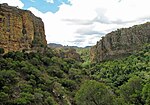The Rova of Antananarivo (Malagasy: Rovan'i Manjakamiadana [ˈruvᵊn manˌdzakəmiˈadə̥nᵊ]) is a royal palace complex (rova) in Madagascar that served as the home of the sovereigns of the Kingdom of Imerina in the 17th and 18th centuries, as well as of the rulers of the Kingdom of Madagascar in the 19th century. Its counterpart is the nearby fortified village of Ambohimanga, which served as the spiritual seat of the kingdom in contrast to the political significance of the Rova in the capital. Located in the central highland city of Antananarivo, the Rova occupies the highest point on Analamanga, formerly the highest of Antananarivo's many hills. Merina king Andrianjaka, who ruled Imerina from around 1610 until 1630, is believed to have captured Analamanga from a Vazimba king around 1610 or 1625 and erected the site's first fortified royal structure. Successive Merina kings continued to rule from the site until the fall of the monarchy in 1896, frequently restoring, modifying or adding royal structures within the compound to suit their needs.
Over time, the number of buildings within the site varied. Andrianjaka founded the Rova with three buildings and a dedicated tomb site in the early 17th century. The number of structures rose to approximately twenty during the late 18th-century reign of King Andrianampoinimerina. By the late 20th century, the Rova's structures had been reduced to eleven, representing various architectural styles and historical periods. The largest and most prominent of these was Manjakamiadana, also known as the "Queen's Palace" after Queen Ranavalona I, for whom the original wooden palace was built between 1839 and 1841 by Frenchman Jean Laborde. In 1867 the palace was encased in stone for Queen Ranavalona II by Scotsman James Cameron, an artisan missionary of the London Missionary Society. The neighbouring Tranovola, a smaller wooden palace constructed in 1819 by Creole trader Louis Gros for King Radama I, was the first multi-story building with verandas in the Rova. The model offered by Tranovola transformed architecture throughout the highlands over the course of the 19th century, inspiring a widespread shift toward two-storey houses with verandas. The Rova grounds also contained a cross-shaped wooden house (Manampisoa) built as the private residence of Queen Rasoherina, a stone Protestant chapel (Fiangonana), nine royal tombs, and a number of named wooden houses built in the traditional style reserved for the andriana (nobles) in Imerina. Among the most significant of these were Besakana, erected in the early 17th century by Andrianjaka and considered the throne of the kingdom, and Mahitsielafanjaka, a later building which came to represent the seat of ancestral spiritual authority at the Rova.
A fire on the night of 6 November 1995 destroyed or damaged all the structures within the Rova complex shortly before it was due to be inscribed on the list of UNESCO World Heritage Sites. Although officially declared an accident, rumours persist that politically motivated arson may have been the actual cause of the fire. The chapel and tombs, as well as Besakana and Mahitsielafanjaka, have since been fully restored with bilateral government donations, state funds and grants from intergovernmental and private donors. Completion of the reconstruction of the Manjakamiadana exterior was estimated for 2012, with interior restoration expected to be completed no earlier than 2013. Once the building is fully restored, Manjakamiadana will serve as a museum showcasing royal artifacts saved from destruction in the fire. Restoration was well underway in June 2020 and a new concrete "Colosseum" was also being built at the Queen's Palace amid some controversy.








